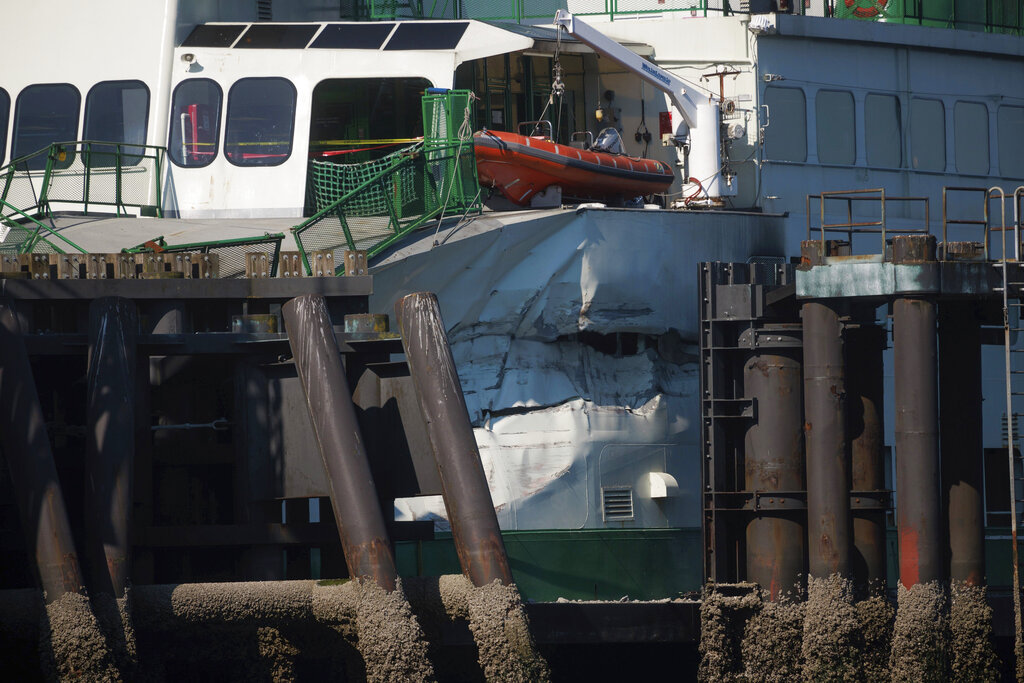SEATTLE — In late September 1986, days after the Cathlamet ferry crashed into the Clinton dock on Whidbey Island, local radio DJ Dave Scott penned a ditty he called “The Wreck of the Ferry Cathlamet.”
It was a play on Gordon Lightfoot’s hit “The Wreck of the Edmund Fitzgerald,” and for days, listeners couldn’t get enough.
“I imagine we’ll play it four times a day until listeners stop requesting it,” Scott said in an Associated Press story at the time.
Nearly 36 years later, the Cathlamet has once again been wrecked, this time near the Fauntleroy dock in West Seattle. The cause of Thursday’s crash, which did not result in any injuries or pollution, is being investigated by the Coast Guard. Petty Officer Steve Strohmaier said the National Transportation Safety Board is sending an investigator, but the Coast Guard will be the lead federal agency.
Washington State Ferries is conducting its own internal investigation, spokesperson Ian Sterling said. Neither the Coast Guard not WSF provided an estimate for the timing of the investigation’s findings, saying they would likely take days or weeks. Strohmaier said investigators would examine all of the boat’s systems, including how it was loaded, its ballast and the amount of fuel onboard, among other factors.
The boat is currently docked at Eagle Harbor on Bainbridge Island where it will be pulled from the water for repairs.
The crash came after the late 7:55 a.m. ferry from Vashon Island to West Seattle veered off its route, missing the Fauntleroy dock entirely and striking the offshore southern pilings with the north side of the boat.
Ferries regularly bump these pilings, which are equipped with shock-absorbent bumpers, but because the ship was so off course, the ferry missed these cushions and hit the hard backside of the pilings. The crash crumpled one corner of the vessel, damaging at least two onboard vehicles.
After the dock was closed for most of Thursday, service to West Seattle was restored late in the day when the Kitsap ferry arrived as a replacement. Early Friday, the Kitsap began experiencing electrical and steering problems, leaving the Fauntleroy-Vashon Island-Southworth route with one boat instead of the usual three.
The Kitsap was back in service by early afternoon.
The lingering question is what caused the ferry to go so off course — human error or mechanical failure. Passengers and witnesses said the ship seemed to be moving quickly as it approached the West Seattle shore; video shows the boat almost running aground and sand being kicked up by the propellers.
“From the witness statements, it was going much faster than we’d think it would be going based on the damage,” Sterling said.
The damage from the crash appears to be cosmetic, Strohmaier said. Investigators were able to power up the boat as well as test the systems and couldn’t find any internal damage. That doesn’t rule out that the crash could have been caused by a preceding mechanical failure.
There were more than 50 passengers and crew on the Cathlamet when it crashed, Sterling said. One car was pinned inside the ferry and made the trip to Bainbridge with the damaged boat.
The Cathlamet is likely to be out for months, putting the ferry system in a tighter squeeze than it already was. It takes 19 boats to run a full schedule. WSF has 21 boats, two of which are held out for maintenance at any given time, said Sterling, leaving very little flexibility.
Last week, the Tacoma ferry hit a crab pot, which wrapped into the propeller, and crews pulled the boat out of the water for repairs. With the Cathlamet crash, only 17 boats were available to use even before the Kitsap went down temporarily Friday.
For now, the issue of crew shortages is worse than the issue of vessel shortages. As a result, many routes are already on reduced schedules because the ferry system couldn’t run 19 boats even if it had them.
But hiring is picking up, Sterling said.
“There could be some impact down the road,” he said. “You have a limited number of vessels and you’re going to be using all of them at some point.”
Both the Cathlamet — Chinook for “stone” — and the Kitsap are part of the Issaquah class of boats that came online in the 1980s. In their early years, the boats gained a reputation for being unreliable — the Cathlamet earned the nickname the “Can’t-land-it” and the “Crash-lamet.” In addition to the 1986 crash, which caused $500,000 damage, the Cathlamet also drifted away from the Mukilteo dock in 1982. A car slipped off the front as a result, but there were no injuries.
“Ferry lore was, you put a quarter in the pop machine and the boat would stop,” Sterling said. The fleet has received upgrades since then and many of those issues resolved, he added.
The Cathlamet was also involved in a 2007 crash at the Mukilteo dock, which ferry officials blamed on a “negligent” captain.
The technology for driving the Cathlamet straddles the old and new. Some of the oldest ferries in the fleet still use a “telegraph” system, in which signals are sent from the captain to the engine crew staff below, who then physically accelerate and slow the boat. The Cathlamet and other Issaquah-class ships were built to run on this system, but have been upgraded to the “fly by wire” technology, in which the captain’s actions trigger an electrical response in the boat’s guts, similar to every modern pleasure cruiser.
The telegraph approach is still functional in the Issaquah ships as a backup, but they’re assumed to be running on more automated technology, Sterling said.
The state of the fleet is at an all-time low, Sterling said. Some of the ships, like the more than 60-year-old Tilikum, are built with World War II technology. This year, the Washington Legislature approved funding for four new hybrid-electric boats, which will take years to come online.



